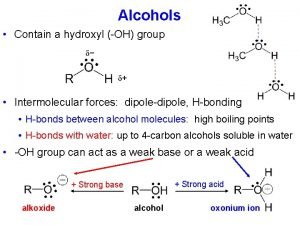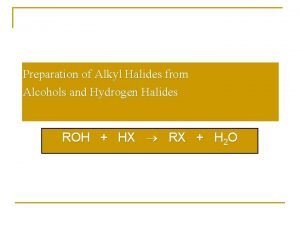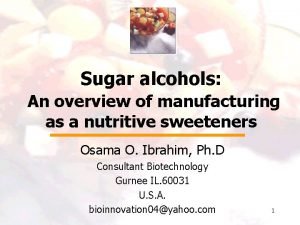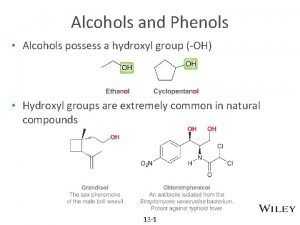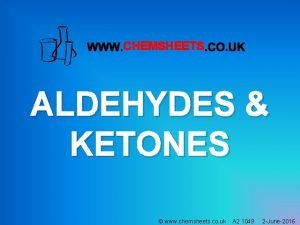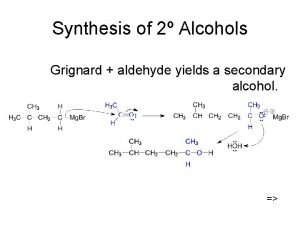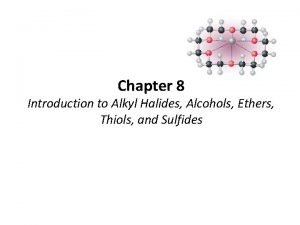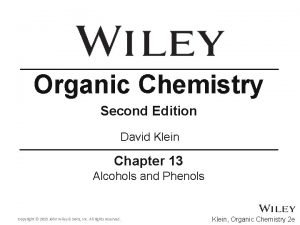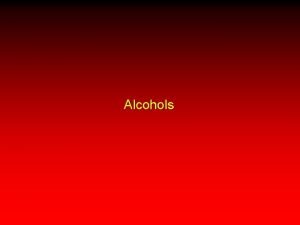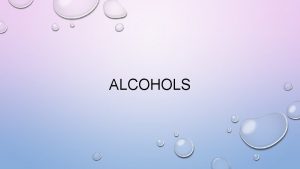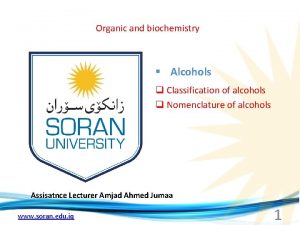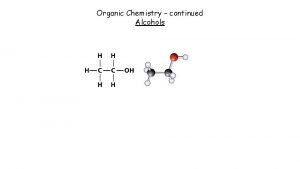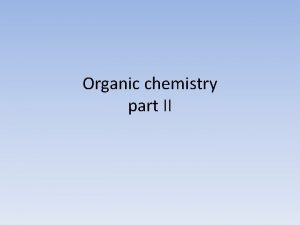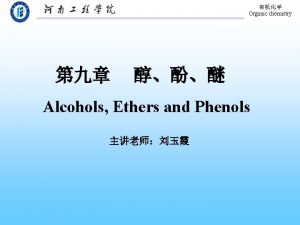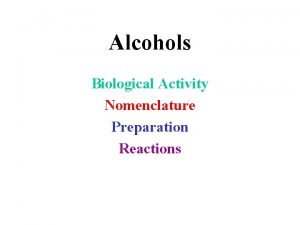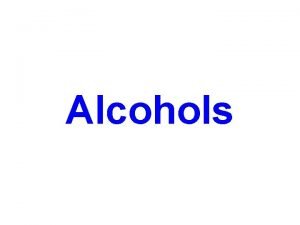EXPERIMENT 2 IDENTIFICATION OF ALCOHOLS Alcohols are organic











- Slides: 11

EXPERIMENT 2 IDENTIFICATION OF ALCOHOLS

Alcohols are organic compounds containing an -OH functional group bonded to a carbon atom. Alcohols may be classified as primary, secondary or tertiary, depending on what kind of carbon the –OH group is attached to. As shown below: Primary alcohol: RCH 2 OH the ‘R’, an alkyl group, and the –OH are attached to a primary carbon atom, a carbon bonded to one other carbon atom. Secondary alcohol: R 2 CHOH, the 2 ‘R’ alkyl groups, and the -OH are attached to a secondary carbon atom, a carbon attached to two other carbon atoms from the 2 ‘R’ (CH 3 -),

Tertiary alcohol: R 3 COH the 3 ‘R’ alkyl groups, and the – OH are attached to a tertiary carbon atom a carbon attached to three other carbon atoms from the 3 ‘R’ (CH 3 -).

The International Union of Pure and Applied Chemistry (IUPAC) method of nomenclature for alcohols use the ending ol. Change the ‘e’ ending of an alkane to ol (i. e methane to methanol, ethane to ethanol , Propane to Propanol …ect ).

Alcohols are important commercially and are used as solvents, drugs and disinfectants. The most widely used alcohols are methanol or methyl alcohol, CH 3 OH; ethanol or ethyl alcohol, CH 3 CH 2 OH; and 2 -propanol or isopropyl alcohol, (CH 3)2 CH 2 OH. Methyl alcohol is found in automotive products such as antifreeze and “dry gas”. Ethyl alcohol is used as a solvent for drugs and chemicals, but is more popularly known for its effects in alcoholic beverages. Isopropyl alcohol, also known as “rubbing alcohol” is an antiseptic.

Manifestation of acidity. Ordinary alcohols do not exhibit much acidity. They are generally neutral in aqueous solutions. Phenols, on the other hand, are much more acidic , Why? and will react with bases such as sodium hydroxide to form soluble salts. This difference is a good way to distinguish between the two types of compounds

Oxidation: Oxidation of alcohols by strong oxidants such as K 2 Cr 2 O 7 in H 2 SO 4 is possible, but differs depending on the degree of alcohol. Examples a, b, and c below show a primary, secondary, and tertiary alcohol respectively respond to treatment of oxidants. If a reaction has occurred using K 2 Cr 2 O 7 in H 2 SO 4, there is a color change from orange to green.



Lucas Test: This test is for low molecular weight alcohols and it distinguishes the rates of reaction of alcohols with the Lucas reagent (HCl and Zn. Cl 2). Positive indicator of the reaction is the formation of a water insoluble alkyl chloride as cloudiness or a precipitate. The formation of an alkyl chloride with tertiary alcohol is very rapid, followed by the secondary alcohol that may take from 5 to 20 minutes to form visible cloudiness. Primary alcohols do not react with Lucas reagent or it may show very little result in a very long time. The chemical reaction involves replacing the –OH group of the alcohol with a chloride ion from hydrochloric acid (HCl), forming an alkyl chloride, as shown in the following equation.




